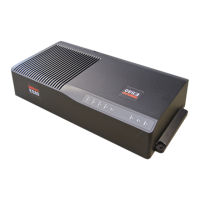406273/C
457
Observationrangeversusoperational
frequency
Absorptionincreasesdramaticallywithfrequencyinsaltwater.Formaximum
observationrangeyoushouldselectalowoperatingfrequency,alargetransducerandthe
maximumtransmitpower.
Thekeyfactsrelatedtoobservationrangeversusoperationalfrequncyare:
•Observationrangeincreaseswhentheoperationalfrequencyisreduced.
•Resolutionincreaseswhentheoperationalfrequencyisincreased.
Ifyouwishtoworkindeepwaters,youneedalowoperationalfrequency.
Ifyouwishtoworkwithhighresolution,youneedahighoperationalfrequency.The
observationrangeisthenlimited.
UsingtheSimradES38Btransducer(38kHz,7x7degrees,2000W)youcanobserve
a60centimetercoddownto950meters,whilebottomdetectionworksdownto2800
meters.However,withtheSimradES200-7Ctransducer(200kHz,7x7degrees,1000
W)youcanonlyobservethatsamecoddownto270meters.Bottomdetectionbecomes
unreliablebelow500meters.
Typicalobservationrangesareshowninthetable.
Maximumdetectiondepth(Split-beamtransducers)
Trans-
ducers
Fre-
quency
(kHz)
Pulse
duration
(ms)
Band-
width
(hz)
TX
Power
(W)
Range
sh
(m)
Range
bottom
(m)
ES18-11188,21382200011007000
ES38B384,0976620009502800
ES70-11702,0515268004501100
ES120-7C1201,0230261000440850
ES200-7C2001,0230881000270550
Maximumdetectiondepth(Single-beamtransducers)
Trans-
ducers
Fre-
quency
(kHz)
Pulse
duration
(ms)
Beam
angle
(deg)
Band-
width
(Hz)
TX
Power
(W)
Range
(m)
38-7384
7
76620003000
38-9384976615002600
38/200D
38413x2176610002100
50/200D
50210x16149310001400
50-185021815265001400
50-7502
7
149320001900
Conceptdescriptions

